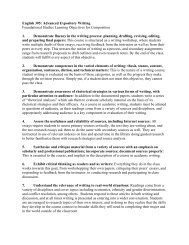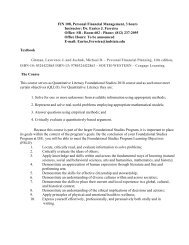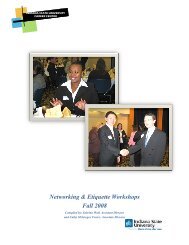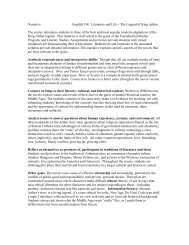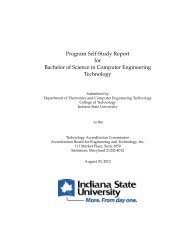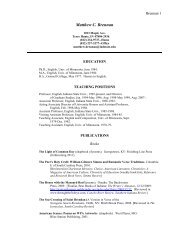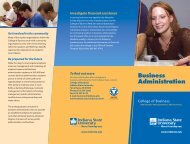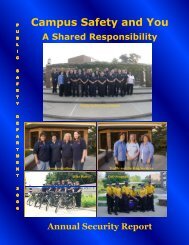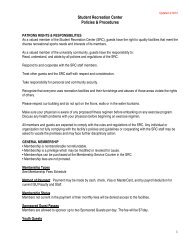MUS 351 - Indiana State University
MUS 351 - Indiana State University
MUS 351 - Indiana State University
You also want an ePaper? Increase the reach of your titles
YUMPU automatically turns print PDFs into web optimized ePapers that Google loves.
2. Explain historical events and changes as a continuous movement through time rather than as<br />
discrete and disconnected moments in time; 2<br />
3. Locate and evaluate sources of evidence within the context of time, place, and culture; and 3<br />
4. Use an historical perspective to understand the world today and address contemporary issues. 4<br />
Ultimately, the course is designed to develop skills directly related to applied learning. As such, the<br />
course will (S&ALO):<br />
1. Contribute to the development of critical thinking skills; 5<br />
2. Contribute to the development of information literacy skills; and 6<br />
3. Include a graded developmental writing component. 7<br />
Required Texts:<br />
1. J. Peter Burkholder, Donald Jay Grout, and Claude V. Palisca, A History of Western Music, 8th<br />
ed. (New York: W. W. Norton, 2010).<br />
2. Norton Anthology of Western Music [NAWM], vol. 2: Classical and Romantic, 6th ed., J. Peter<br />
Burkholder and Claude V. Palisca, eds. (New York: W. W. Norton, 2010).<br />
3. Norton Anthology of Western Music [NAWM], vol. 3: Twentieth Century, 6th ed., J. Peter<br />
Burkholder and Claude V. Palisca, eds. (New York: W. W. Norton, 2010).<br />
important change in music aesthetics and compositional practices throughout Europe and the United <strong>State</strong>s. [FSLO<br />
4, 6, 7]<br />
2 Much of the music examined as part of this course is linked by genre. As such, one of the main focuses of the<br />
course is the historical development of genres, for instance symphony, opera, concerto, and sonata. Moreover, some<br />
historical concepts (e.g. Industrial revolution and the creation of strong nationalistic sensitivities) are explored as<br />
long-lasting influences, the significance of which continued beyond the music of a single period in time.<br />
3 The Weiss/Taruskin text contains a collection of historical source readings that provide contemporaneous accounts<br />
of music making, aesthetic values, and performance reviews of the music discussed in the text. These source<br />
readings primary documents and serve as the historical backdrop against which the music analysis occurs, thus<br />
allowing students to see how the various compositions discussed in class serve as documents of the times during<br />
which they were composed. Although these documents will be used throughout the semester, documents related<br />
specifically to the controversial premiere of Igor Stravinsky’s Rite of Spring will be used as part of a larger project<br />
that will culminate in an essay exploring the reception of the work at the time of its premiere. [HSLO 1, 2, 3, 4]<br />
4 The Living Composer Project is designed to allow students an opportunity to discuss how music composed today<br />
is a product of (literally) centuries of influence by earlier composers, works, historical events, etc. By interviewing a<br />
living composer, students are made aware of not only the problems faced by modern composers, but how these<br />
individuals tackle the challenges they encounter, how they make their living, how they are trained, how they music<br />
reflects their various influences, and their opinions about the current state of Western art music composition.<br />
Ultimately, this project is to reinforce the notion that the composition of music is a living/breathing art form.<br />
5 One of the goals of the course is to provide students with a core repertory of musical works against which they can<br />
compare unknown works of music when they encounter them. By drawing upon their knowledge of these<br />
representative compositions, students can then employ critical thinking skills and make informed decisions about the<br />
possible historical, cultural, and/or stylistic origins of unknown works of music.<br />
6 Part of the process students go through for the developmental writing projects includes the development of a<br />
proposal and annotated bibliography. This bibliography is developed in conjunction with the music librarian who<br />
provides separate, mandatory workshops on bibliographic techniques and the use of library catalogs and databases.<br />
The topics of these workshops are larged geared toward the use of electronic library resources, and specifically those<br />
in the field of music. In addition to the traditional full-text databases such as JSTOR, music students learn to use<br />
electronic resources in the field, enabling them to access streaming audio and video materials as well as electronic<br />
versions of music scores. Advanced and Honors Program students also work with a librarian to learn to use EndNote<br />
software in order to develop better information and bibliographic management resources and skills. [FSLO 1, 10]<br />
7 All major writing assignments for this course are developmental and address all four major stages of the writing<br />
process: Planning/Development, Drafting, Revising, and Editing. [FSLO 1, 2, 3, 10]<br />
2





